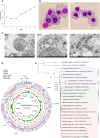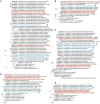Genomic characterization of an emerging Rickettsia barbariae isolated from tick eggs in northwestern China
- PMID: 39193640
- PMCID: PMC11378659
- DOI: 10.1080/22221751.2024.2396870
Genomic characterization of an emerging Rickettsia barbariae isolated from tick eggs in northwestern China
Abstract
The continual emergence of tick-borne rickettsioses has garnered widespread global attention. Candidatus Rickettsia barbariae (Candidatus R. barbariae), which emerged in Italy in 2008, has been detected in humans from northwestern China. However, the lack of Candidatus R. barbariae genome and isolated strains limits the understanding of its biological characteristics and genomic features. Here, we isolated the Rickettsia for the first time from eggs of Rhipicephalus turanicus in northwestern China, and assembled its whole genome after next-generation sequencing, so we modified the proposed name to Rickettsia barbariae (R. barbariae) to conform to the International Code of Nomenclature of Prokaryotes. Phylogenetic analysis based on the whole genome revealed that it was most closely related to the pathogenic Rickettsia parkeri and Rickettsia africae. All virulence factors, present in the pathogenic spotted fever group rickettsiae, were identified in the R. barbariae isolate. These findings highlight the pathogenic potential of R. barbariae and the necessity for enhanced surveillance of the emerging Rickettsia in the human population.
Keywords: China; Rhipicephalus turanicus; Rickettsia barbariae; phylogenetic analysis; virulence factors; whole-genome sequencing.
Conflict of interest statement
No potential conflict of interest was reported by the author(s).
Figures



Similar articles
-
Rickettsia africae and Candidatus Rickettsia barbariae in ticks in Israel.Am J Trop Med Hyg. 2014 May;90(5):920-2. doi: 10.4269/ajtmh.13-0697. Epub 2014 Mar 10. Am J Trop Med Hyg. 2014. PMID: 24615133 Free PMC article.
-
Diversity of Rickettsia species in border regions of northwestern China.Parasit Vectors. 2018 Dec 13;11(1):634. doi: 10.1186/s13071-018-3233-6. Parasit Vectors. 2018. PMID: 30545379 Free PMC article.
-
First direct detection of rickettsial pathogens and a new rickettsia, 'Candidatus Rickettsia barbariae', in ticks from Sardinia, Italy.Clin Microbiol Infect. 2008 Nov;14(11):1028-33. doi: 10.1111/j.1469-0691.2008.02082.x. Clin Microbiol Infect. 2008. PMID: 19040474
-
Tick-borne diseases: tick-borne spotted fever rickettsioses in Africa.Infect Dis Clin North Am. 2008 Sep;22(3):531-44, ix-x. doi: 10.1016/j.idc.2008.03.009. Infect Dis Clin North Am. 2008. PMID: 18755389 Review.
-
Tick-borne rickettsioses in Europe.Ticks Tick Borne Dis. 2012 Dec;3(5-6):271-8. doi: 10.1016/j.ttbdis.2012.10.035. Epub 2012 Nov 21. Ticks Tick Borne Dis. 2012. PMID: 23177355 Review.
Cited by
-
First detection of a lizard-associated papillomavirus in the splendid japalure (Japalura splendida) from southwestern China.Front Microbiol. 2025 Jul 28;16:1590538. doi: 10.3389/fmicb.2025.1590538. eCollection 2025. Front Microbiol. 2025. PMID: 40792270 Free PMC article.
References
MeSH terms
Substances
Supplementary concepts
LinkOut - more resources
Full Text Sources
Other Literature Sources
